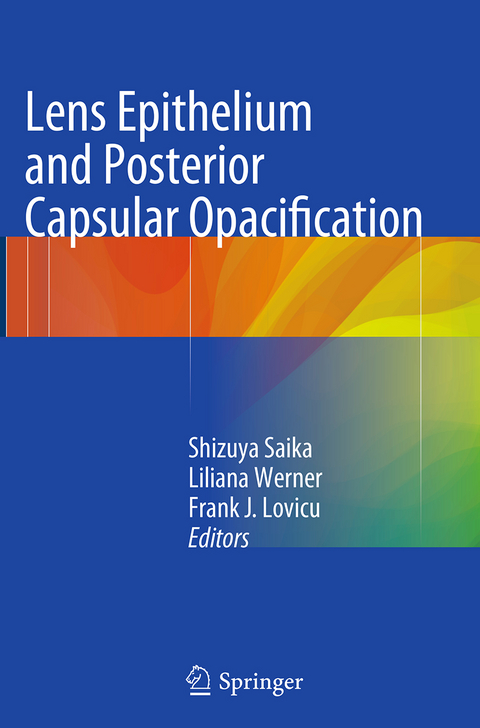
Lens Epithelium and Posterior Capsular Opacification
Springer Verlag, Japan
978-4-431-56140-8 (ISBN)
The first section of the text explains the molecular mechanism and biology of lens epithelial cells that lead to the incidence of PCO. In the second part, in addition to a description of the mechanism and pathological condition of PCO, surgical methods and devices for preventing PCO are discussed in detail. Lens Epithelium and Capsular Opacification will benefit not only young clinical residents and junior researchers, but also established faculty in the clinical or basic academic field.
Shizuya Saika, M.D. , Ph.D. Dr. Shizuya Saika is chairman/professor of the Department of Ophthalmology, Wakayama Medical University School of Medicine, Wakayama, Japan. Dr. Saika completed his M.D. in 1988 and his Ph.D. in 1993 from this university. He was also engaged in basic science research in the Department of Ophthalmology, University of Cincinnati School of Medicine, Ohio, USA, in 1998 –1999. He has been engaged in basic science research in wound healing of lens and cornea besides his clinical work, especially of surgeries for cataract, glaucoma and vitreoretinal disorders. Liliana Werner, M.D., Ph.D. Liliana Werner, M.D., Ph.D., is a tenured associate professor of ophthalmology and visual sciences and co-director of the Intermountain Ocular Research Center at the John A. Moran Eye Center, University of Utah, Salt Lake City, UT, USA. She has an M.D. degree from Brazil and a Ph.D. degree (biomaterials) from France. Dr. Werner’s research is centered on the interaction between ocular tissues and different intraocular lens designs, materials and surface modifications. These include intraocular lenses implanted after cataract surgery and also phakic lenses for refractive surgery as well as ophthalmic implantable devices in general. Frank J. Lovicu, Ph.D. Dr. Frank J. Lovicu is a professor in the School of Medical Sciences, in the Discipline of Anatomy and Histology, Bosch Institute and Save Sight Institute, at the University of Sydney, NSW, Australia. He currently heads the Lens Research Laboratory in Anatomy and Histology, where he primarily studies the role of growth factor signaling in regulating lens cell behavior. His research promotes the understanding of the cellular and molecular processes leading to normal lens development and growth, as well as those leading to cataract. His research findings have the potential for development of new strategies to treat and/orprevent cataract.
PART I: Lens Epithelial Cell Biology.- Chapter 1. From Zygote to Lens: Emergence of the Lens Epithelium.- Chapter 2. Cell Biology of Lens Epithelial Cells.- Chapter 3. The Lens Capsule – Synthesis, Remodeling and MMPs.- Chapter 4. Lens Epithelial Cell Proliferation.- Chapter 5. Growth Factor Signaling in Lens Fiber Differentiation.- Chapter 6. Lens-Specific Transcription Factors and Their Roles in Diagnosis and Treatment of Human Congenital Cataract.- Chapter 7. Lens Regeneration.- Chapter 8. Fibrotic Modifications of the Lens Epithelium.- Chapter 9. Wound Healing and Epithelial-Mesenchymal Transition in the Lens Epithelium: Roles of Growth Factors and Extracellular Matrix.- Part II: Clinical Science -Pathology.- Chapter 10. Histology of Posterior Capsular Opacification.- Chapter 11. PCO Rates in a Large Series of Human Eyes Obtained Post-Mortem.- Part III: Clinical Outcomes.- Chapter 12. Natural Course of Elschnig Pearl Formation and Disappearance.- Chapter 13. Effect of Posterior Capsule Opacification and Anterior Capsule Contraction on Visual Function.- PART IV: Surgical Methods for PCO Prevention.- Chapter 14. Size of Continuous Curvilinear Capsulorhexis for Prevention of PCO.- Chapter 15. Effect of Anterior Capsule Polishing on Capsule Opacification and YAG Laser Capsulotomy.- Chapter 16. Laser Photolysis System and PCO Prevention.- PART V: Intraocular Lenses/Devices and PCO.- Chapter 17. PCO Prevention: IOL Material Versus IOL Design.- Chapter 18. Capsular and Uveal Biocompatibility of Different IOLs in Eyes with and Without Associated Conditions.- Chapter 19. Capsule-Bending Ring for the Prevention of Posterior Capsule Opacification.- Chapter 20. PCO Prevention with Endocapsular Equator Rings.- Chapter 21. PCO Prevention with IOLs Maintaining an Open or Expanded Capsular Bag.- Chapter 22. Prevention of PCO with the Bag-in-the-lens (BIL).- Chapter 23. Posterior capsule Opacification with Micro incision (MICS) IOLs.- PART VI: Special Cases.- Chapter24. PCO and the Pediatric Eye.
| Erscheinungsdatum | 23.09.2022 |
|---|---|
| Zusatzinfo | 140 Illustrations, color; 35 Illustrations, black and white; XVII, 424 p. 175 illus., 140 illus. in color. |
| Verlagsort | Tokyo |
| Sprache | englisch |
| Maße | 155 x 235 mm |
| Themenwelt | Medizin / Pharmazie ► Medizinische Fachgebiete ► Augenheilkunde |
| Naturwissenschaften ► Biologie ► Zellbiologie | |
| Schlagworte | Biomaterial • Cataract Surgery • Growth factor • intraocular lens • lens epithelial cell • postoperative capsular opacification |
| ISBN-10 | 4-431-56140-4 / 4431561404 |
| ISBN-13 | 978-4-431-56140-8 / 9784431561408 |
| Zustand | Neuware |
| Haben Sie eine Frage zum Produkt? |
aus dem Bereich


